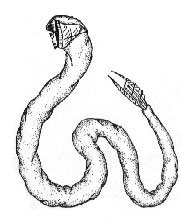On his 4th voyage over to America, Christopher Columbus lost all of his ships to shipworms. All of them. Why was so little wood found on the sunken Titanic when they finally raised it from the ocean floor? You got it…shipworms. You got that right, right?
Mollusks, Actually
So what are shipworms…and why and how do they cause so much damage? Shipworms (also known as Pileworms) actually are not really worms at all, but are rather a type of clam that has very small shells used for boring into wood in saltwater.
A marine bivalve mollusk (with 65 different species)…they get their name for their long, narrow, cylindrical bodies – resembling worms. However, upon closer inspection, you will find a small drill-like shell. This shell has two halves with a gap between them, like a clamshell. In the gap there is a muscular foot that acts as a suction cup, holding the shell in place while it’s razor-sharp edges scrape the wood ahead of it. Shipworms have long tubes that stick out into the water so the worm can breathe, and can also seal the worm in the wood in cases of extended periods out of water…low tides for example.
Up To 6 Feet Long
 Also known as “Termites of the sea”, shipworms eat sawdust. The stomach of shipworms has a pouch for storing sawdust and an organ/gland full of bacteria that aide in digesting wood. The bacteria take nitrogen from the water and convert it to protein for the worms’ nourishment. The shipworm invades wood while still in the larval stage, making an entrance hall that is usually too small to see. It uses the shells on its head to burrow. The ridged, rough surfaces rub the wood away as the worm moves from side to side. This cuts away a perfectly circular tube that is just larger than the shell. The wormlike body follows behind the shell, producing a chalk-like substance to line the burrow. As they burrow deeply into the wood, they grow very quickly. As the worm grows, so does the burrow. Depending on the size of their homes, shipworms can range in size from 6 inches to as long as 6 feet.
Also known as “Termites of the sea”, shipworms eat sawdust. The stomach of shipworms has a pouch for storing sawdust and an organ/gland full of bacteria that aide in digesting wood. The bacteria take nitrogen from the water and convert it to protein for the worms’ nourishment. The shipworm invades wood while still in the larval stage, making an entrance hall that is usually too small to see. It uses the shells on its head to burrow. The ridged, rough surfaces rub the wood away as the worm moves from side to side. This cuts away a perfectly circular tube that is just larger than the shell. The wormlike body follows behind the shell, producing a chalk-like substance to line the burrow. As they burrow deeply into the wood, they grow very quickly. As the worm grows, so does the burrow. Depending on the size of their homes, shipworms can range in size from 6 inches to as long as 6 feet.
Expensive Damages
Once a shipworm claims a home, it is there for life. A piece of wood may be infested with shipworm, but they will deliberately avoid each other’s tunnels. Instead they twist and turn their tunnels until the wood becomes a mass of tubes and holes, and eventually collapses. Shipworms are sometimes called the mollusk with the million-dollar appetite. These creatures are credited with single-handedly destroying the Hudson River piers in New York City. Researchers estimate that untreated timbers, such as pier pilings, exposed to Hawaii’s ocean waters will last less than two years.
A Positive Note
However, this incredible appetite has a purpose. Large amounts of wood get into the oceans by river deposits, forests and mostly, humans. Shipworms play an integral role in reducing the amount of driftwood in the world’s oceans.
How To Stop Shipworms
So, how do we stop the shipworms & protect our ships & wooden structures? By protesting at the White House? Not likely. Shipworms don’t like copper….so we can build using copper nails, or even copper sheeting. A cheaper and easier method is simply using CCA treated wood which contains copper (CCA = Chromated COPPER Arsenate).
Well, We Like Oysters
Or, we can eat them. In some places, shipworms are considered a culinary delicacy. In the Philippines, it is prepared as ‘kinilaw’ – eaten raw, with vinegar or lime juice & chopped peppers and onions…Similar to ceviche. The taste has been compared to a very wide variety of foods ranging from milk to oysters.